Enhancing Offshore Wind Turbine Integrity Management: A Bibliometric Analysis of Structural Health Monitoring, Digital Twins, and Risk-Based Inspection
Abstract
1. Introduction
2. Methodology
2.1. Search Terms
- Offshore wind energy: “offshore wind” The first group targets the broad context of offshore wind energy systems. The results offer an overview of the evolution and current state of knowledge in offshore wind energy. When combined with terms from Groups 2–5, they help delineate the theoretical, methodological, and technological advancements in offshore wind energy applications, highlighting trends over time, geographic areas, and key research and development (R&D) actors.
- Normative decision-making: “reliability” OR “risk” OR “resilience” OR “resilient” OR “sustainability” OR “sustainable”This group contains search terms related to normative decision-making and is exclusively used in combination with other groups, i.e., these search terms are not queried individually from the database. The results provide insights into available knowledge regarding strategic and operational planning, governance, and regulation at both pre-normative and normative levels.
- Risk-based inspection planning: (“integrity management” AND “reliability”) OR “risk based inspection” OR “risk-based inspection” OR “reliability based inspection” OR “reliability-based inspection”The third group of search terms pertains to the methodology of RBI for optimal integrity management. The results deliver a general overview of theoretical, methodological, and technological advancements over time, across various geographic regions, and by different R&D contributors.
- Structural health monitoring: “structural health monitoring” OR (“condition monitoring” AND “structure”) OR (condition monitoring” AND “structures”) OR (“condition monitoring AND “structural”) OR “SCADA” OR “structural damage detection”The search terms of the fourth group focus on the process of SHM during the operation and maintenance phases of a structure’s life-cycle. The results offer detailed information on theoretical, methodological, and technological developments over time, geographic distribution, and key R&D actors.
- Digital twin technology: “digital twin” OR “digital twins”The search terms of this group relate to DT technology, covering both modeling and application aspects. The results provide comprehensive information on theoretical and methodological advancements over time, across different regions, and by various R&D actors. These data can be used comparatively to assess the transferability of digital twin technology across diverse applications.
2.2. Data Collection
2.3. Bibliometric Networks in Research Visualization
3. Visualization and Data Analysis
3.1. Term Co-Occurrence Analysis Results
3.2. Bibliographic Coupling Analysis Results
- RBI: USA, Canada, England
- SHM: China, USA, England
- DTs: China, USA, and Germany
4. Conclusions and Road Map
Road Map for Future Research and Development for Enhancing Best Practice for Integrity Management
Author Contributions
Funding
Data Availability Statement
Acknowledgments
Conflicts of Interest
References
- European Commission. COM/2023/668—Communication from the Commission to the European Parliament, the Council, the European Economic and Social Committee and the Committee of the Regions; European Commission: Brussels, Belgium, 2023. [Google Scholar]
- Wind Europe. Wind Energy in Europe—2023 Statistics and the Outlook for 2024–2030. 2024. Available online: https://windeurope.org/intelligence-platform/product/wind-energy-in-europe-2023-statistics-and-the-outlook-for-2024-2030/ (accessed on 2 September 2024).
- BVGassociates. Guide to an Offshore Wind Farm—Updated and Extended. 2019. Available online: https://guidetoanoffshorewindfarm.com/ (accessed on 2 September 2024).
- Dewan, A.; Asgarpour, M. Reference O&M Concepts for Near and Far Offshore Wind Farms 2016. ECN-E–16-055. Available online: https://publicaties.ecn.nl/PdfFetch.aspx?nr=ECN-E–16-055 (accessed on 9 September 2024).
- Ambühl, S.; Sørensen, J.D. Different Transportation and Maintenance Strategies for Offshore Wind Farms; DCE Technical Reports No. 227; Department of Civil Engineering, Aalborg University: Aalborg, Danmark, 2017. [Google Scholar]
- Besnard, F.; Nilsson, J.; Bertling, L. On the economic benefits of using Condition Monitoring Systems for maintenance management of wind power systems. In Proceedings of the 2010 IEEE 11th International Conference on Probabilistic Methods Applied to Power Systems, Singapore, 14–17 June 2010; pp. 160–165. [Google Scholar] [CrossRef]
- Jonker, T. The Development of Maintenance Strategies of Offshore Wind Farm; ME54010; Marine and Transport Technology, Delft University of Technology: Delft, The Netherlands, 2017. [Google Scholar]
- Scheu, M.; Matha, D.; Hofmann, M.; Muskulus, M. Maintenance Strategies for Large Offshore Wind Farms. Energy Procedia 2012, 24, 281–288. [Google Scholar] [CrossRef]
- Márquez, F.P.G.; Papaelias, M. An overview of wind turbine maintenance management. In Non-Destructive Testing and Condition Monitoring Techniques for Renewable Energy Industrial Assets; Elsevier: Amsterdam, The Netherlands, 2020; pp. 31–47. [Google Scholar] [CrossRef]
- Peinado Gonzalo, A.; Benmessaoud, T.; Entezami, M.; García Márquez, F.P. Optimal maintenance management of offshore wind turbines by minimizing the costs. Sustain. Energy Technol. Assess. 2022, 52, 102230. [Google Scholar] [CrossRef]
- Raza, A.; Ulansky, V. Optimal Preventive Maintenance of Wind Turbine Components with Imperfect Continuous Condition Monitoring. Energies 2019, 12, 3801. [Google Scholar] [CrossRef]
- Biswal, R.; Mehmanparast, A. Fatigue damage analysis of offshore wind turbine monopile weldments. Procedia Struct. Integr. 2019, 17, 643–650. [Google Scholar] [CrossRef]
- McGugan, M.; Mishnaevsky, L. Damage Mechanism Based Approach to the Structural Health Monitoring of Wind Turbine Blades. Coatings 2020, 10, 1223. [Google Scholar] [CrossRef]
- Raiffa, H.; Schlaifer, R. Applied Statistical Decision Theory, 5th ed.; Harvard University: Cambridge, MA, USA, 1961; 356p. [Google Scholar]
- Freudenthal, A.M. Safety of Structures. Trans. ASCE 112, 1255180 1947, 1, 125–159. [Google Scholar] [CrossRef]
- Sørensen, J.D.; Rackwitz, R.; Faber, M.H.; Thoft-Christensen, P. Modelling in Optimal Inspection and Repair. Proc. Int. Conf. Offshore Mech. Arct. Eng. 1991, 2, 281–288. [Google Scholar]
- Kirkemo, F. Probabilistic strategy increases jacket in-service inspection efficiency. Offshore 1990, 50, 46–47. [Google Scholar]
- Faber, M.; Sørensen, J.; Kroon, I. Optimal inspection Strategies for Offshore Structural Systems. In Proceedings of the 11th International Conference on Offshore Mechanics and Arctic Engineering. American Society of Mechanical Engineers, Calgary, Alberta, 7–12 June 1992; Volume 2, pp. 145–151. [Google Scholar]
- Moan, T.; Song, R. Implications of Inspection Updating on System Fatigue Reliability of Offshore Structures. J. Offshore Mech. Arct. Eng. 2000, 122, 173–180. [Google Scholar] [CrossRef]
- Straub, D.; Faber, M. Risk based acceptance criteria for joints subject to fatigue deterioration. In Proceedings of the International Conference on Offshore Mechanics and Arctic Engineering—OMAE, Cancun, Mexico, 8–13 June 2003; Volume 2, pp. 179–188. [Google Scholar] [CrossRef]
- Goyet, J.; Rouhan, A.; Faber, M.H. Industrial implementation of risk based inspection planning methods—Lessons learnt from experience: The case of FPSOs. Proc. Int. Conf. Offshore Mech. Arct. Eng. 2004, 2, 553–563. [Google Scholar]
- Faber, M.H.; Sørensen, J.D.; Tychsen, J.; Straub, D. Field implementation of RBI for jacket structures. J. Offshore Arct. Eng. 2005, 127, 220–226. [Google Scholar] [CrossRef]
- Straub, D. Generic Approaches to Risk Based Inspection Planning for Steel Structures. Ph.D. Thesis, ETH Zurich, Zurich, Switzerland, 2004. [Google Scholar]
- Faber, M.H. Risk Informed Structural Systems Integrity Management: A Decision Analytical Perspective. In Proceedings of the ASME 2017 36th International Conference on Ocean, Offshore and Arctic Engineering, Trondheim, Norway, 25–30 June 2017; Volume 9. [Google Scholar] [CrossRef]
- Wang, M.; Wang, C.; Hnydiuk-Stefan, A.; Feng, S.; Atilla, I.; Li, Z. Recent progress on reliability analysis of offshore wind turbine support structures considering digital twin solutions. Ocean Eng. 2021, 232, 109168. [Google Scholar] [CrossRef]
- Moghadam, F.K.; Nejad, A.R. Online condition monitoring of floating wind turbines drivetrain by means of digital twin. Mech. Syst. Signal Process. 2022, 162, 108087. [Google Scholar] [CrossRef]
- Allen, D.B. Digital Twins and Living Models at NASA 2021. Keynote Presentation at the ASME Digital Twin Summit. Available online: https://ntrs.nasa.gov/api/citations/20210023699/downloads/ASME%20Digital%20Twin%20Summit%20Keynote_final.pdf (accessed on 9 September 2024).
- Nabuco, B.; Tarpø, M.; Tygesen, U.T.; Brincker, R. Fatigue Stress Estimation of an Offshore Jacket Structure Based on Operational Modal Analysis. Shock Vib. 2020, 7890247. [Google Scholar] [CrossRef]
- Jasiński, M.; Łaziński, P.; Piotrowski, D. The Concept of Creating Digital Twins of Bridges Using Load Tests. Sensors 2023, 23, 7349. [Google Scholar] [CrossRef]
- Najafi, A.; Amir, Z.; Salman, B.; Sanaei, P.; Lojano-Quispe, E.; Maher, A.; Schaefer, R. A Digital Twin Framework for Bridges. Comput. Civ. Eng. 2023, 433–441. [Google Scholar] [CrossRef]
- Yin Z, H.; Wang, L. Application and Development Prospect of Digital Twin Technology in Aerospace. IFAC-PapersOnLine 2020, 53, 732–737. [Google Scholar] [CrossRef]
- Toftekær, J.; Vestermark, J.; Jepsen, M. Uncertainty of Virtually Sensed Stress Ranges in Offshore Wind Support Structures. In Proceedings of the ASME 2023 42nd International Conference on Ocean, Offshore and Arctic Engineering, Melbourne, Australia, 11–16 June 2023. [Google Scholar] [CrossRef]
- Henkel, M.; Häfele, J.; Weijtjens, W.; Devriendt, C.; Gebhardt, C.; Rolfes, R. Strain estimation for offshore wind turbines with jacket substructures using dual-band modal expansion. Mar. Struct. 2020, 71, 102731. [Google Scholar] [CrossRef]
- Maes, K.; Iliopoulos, A.; Weijtjens, W.; Devriendt, C.; Lombaert, G. Dynamic strain estimation for fatigue assessment of an offshore monopile wind turbine using filtering and modal expansion algorithms. Mech. Syst. Signal Process. 2016, 76–77, 592–611. [Google Scholar] [CrossRef]
- Qaiser, M.T.; Ejaz, J.; Osen, O.; Hasan, A. Digital twin-driven energy modeling of Hywind Tampen floating wind farm. Energy Rep. 2023, 9, 284–289. [Google Scholar] [CrossRef]
- Liu, Y.; Zhang, J.M.; Min, Y.T.; Yu, Y.; Lin, C.; Hu, Z.Z. A digital twin-based framework for simulation and monitoring analysis of floating wind turbine structures. Ocean Eng. 2023, 283, 115009. [Google Scholar] [CrossRef]
- El Bazi, N.; Laayati, O.; Darkaoui, N.; El Maghraoui, A.; Guennouni, N.; Chebak, A.; Mabrouki, M. Scalable Compositional Digital Twin-Based Monitoring System for Production Management: Design and Development in an Experimental Open-Pit Mine. Designs 2024, 8, 40. [Google Scholar] [CrossRef]
- Natke, H. Einführung in Theorie und Praxis der Zeitreihen- und Modalanalyse; Springer: Berlin/Heidelberg, Germany, 1982. [Google Scholar] [CrossRef]
- Mottershead, J.; Friswell, M. Model Updating In Structural Dynamics: A Survey. J. Sound Vib. 1993, 167, 347–375. [Google Scholar] [CrossRef]
- Pilkey, W.D. System Identification of Vibrating Structures: Mathematical Models From Test Data; American Society of Mechanical Engineers: New York, NY, USA, 1972. [Google Scholar]
- Beck, J.L.; Katafygiotis, L.S. Updating Models and Their Uncertainties. I: Bayesian Statistical Framework. J. Eng. Mech. 1998, 124, 455–461. [Google Scholar] [CrossRef]
- Ramírez, J.G.R.; Sørensen, J.D. Maintenance Planning of Offshore Wind Turbine using Condition Monitoring Information. In Proceedings of the 28th International Conference on Ocean, Offshore and Arctic Engineering, Honolulu, HI, USA, 31 May–5 June 2009. [Google Scholar]
- Guo, P.; Bai, N. Wind Turbine Gearbox Condition Monitoring with AAKR and Moving Window Statistic Methods. Energies 2011, 11, 2077–2093. [Google Scholar] [CrossRef]
- Gharehbaghi, V.R.; Noroozinejad Farsangi, E.; Noori, M.; Yang, T.Y.; Li, S.; Nguyen, A.; Málaga-Chuquitaype, C.; Gardoni, P.; Mirjalili, S. A Critical Review on Structural Health Monitoring: Definitions, Methods, and Perspectives. Arch. Comput. Methods Eng. 2022, 29, 2209–2235. [Google Scholar] [CrossRef]
- Ross, R. Integrated vehicle health management in aerospace structures. In Structural Health Monitoring (SHM) in Aerospace Structures; Woodhead Publishing: Cambridge, UK, 2016; pp. 3–31. [Google Scholar] [CrossRef]
- Farrar, C.; Worden, K. Structural Health Monitoring: A Machine Learning Perspective; John Wiley & Sons: Hoboken, NJ, USA, 2012. [Google Scholar] [CrossRef]
- Farrar, C.; Lieven, N. Damage prognosis: The future of structural health monitoring. Philos. Trans. Ser. A Math. Phys. Eng. Sci. 2006, 365, 623–632. [Google Scholar] [CrossRef]
- Rytter, A. Vibrational Based Inspection of Civil Engineering Structures. Ph.D. Thesis, Aalborg University, Aalborg, Danmark, 1993. [Google Scholar]
- Figueiredo, E.; Brownjohn, J. Three decades of statistical pattern recognition paradigm for SHM of bridges. Struct. Health Monit. 2022, 21, 3018–3054. [Google Scholar] [CrossRef]
- Keshmiry, A.; Hassani, S.; Mousavi, M.; Dackermann, U. Effects of Environmental and Operational Conditions on Structural Health Monitoring and Non-Destructive Testing: A Systematic Review. Buildings 2023, 13, 918. [Google Scholar] [CrossRef]
- Hoon, S. Effects of environmental and operational variability on structural health monitoring. Phil. Trans. R. Soc. A. 2007, 365, 539–560. [Google Scholar] [CrossRef]
- Schröder, K.; Gebhardt, C.G.; Rolfes, R. A two-step approach to damage localization at supporting structures of offshore wind turbines. Struct. Health Monit. 2018, 17, 1313–1330. [Google Scholar] [CrossRef]
- Long, L.; Mai, Q.A.; Morato, P.G.; Sørensen, J.D.; Thöns, S. Information value-based optimization of structural and environmental monitoring for offshore wind turbines support structures. Renew. Energy 2020, 159, 1036–1046. [Google Scholar] [CrossRef]
- Faber, M.H.; Thöns, S. On the value of structural health monitoring. In Safety, Reliability and Risk Analysis; CRC Press: Boca Raton, FL, USA, 2013; pp. 2535–2544. [Google Scholar] [CrossRef]
- Weijtjens, W.; Verbelen, T.; Sitter, G.D.; Devriendt, C. Foundation structural monitoring of an offshore wind turbine—A full-scale case study. Struct. Health Monit. 2016, 15, 489–502. [Google Scholar] [CrossRef]
- Nabuco, B.; Faber, H.B.M.H.; Brincker, R. A first step in quantifying the value of OMA based fatigue stress estimation. In Proceedings of the 8th International Operational Modal Analysis Conference, Trondheim, Norway, 25–30 June 2019; pp. 645–652. [Google Scholar] [CrossRef]
- Farhan, M.; Schneider, R.; Thöns, S. Predictive information and maintenance optimization based on decision theory: A case study considering a welded joint in an offshore wind turbine support structure. Struct. Health Monit. 2022, 21, 185–207. [Google Scholar] [CrossRef]
- Faber, M. Towards a New Paradigm in the Governance and Management of the Built Environment. In Proceedings of the IABSE Conference Seoul 2020, Seoul, Republic of Korea, 9–10 November 2020; pp. 10–17. [Google Scholar]
- Pranckutė, R. Web of Science (WoS) and Scopus: The Titans of Bibliographic Information in Today’s Academic World. Publications 2021, 9, 12. [Google Scholar] [CrossRef]
- Thelwall, M.; Sud, P. Scopus 1900–2020: Growth in articles, abstracts, countries, fields, and journals. Quant. Sci. Stud. 2022, 3, 37–50. [Google Scholar] [CrossRef]
- Mongeon, P.; Paul-Hus, A. The Journal Coverage of Web of Science and Scopus: A Comparative Analysis. Scientometrics 2015, 106, 213–228. [Google Scholar] [CrossRef]
- van Eck, N.J.; Waltma, L. VOSviewer Manual 2022. Man. VOSviewer Version 2011, 1, 1–27. [Google Scholar]
- Li, S.; Brennan, F. Implementation of digital twin-enabled virtually monitored data in inspection planning. Appl. Ocean. Res. 2024, 144, 103903. [Google Scholar] [CrossRef]
- Tygesen, U.T.; Jepsen, M.S.; Vestermark, J.; Dollerup, N.; Pedersen, A. The True Digital Twin Concept for Fatigue Re-Assessment of Marine Structures. Volume 1: Offshore Technology. In Proceedings of the ASME 2018 37th International Conference on Ocean, Offshore and Arctic Engineering, Madrid, Spain, 17–22 June 2018. [Google Scholar] [CrossRef]
- Tygesen, U.T.; Worden, K.; Rogers, T.; Manson, G.; Cross, E.J. State-of-the-Art and Future Directions for Predictive Modelling of Offshore Structure Dynamics Using Machine Learning. In Proceedings of the Dynamics of Civil Structures, Volume 2; Pakzad, S., Ed.; Springer International Publishing: Berlin/Heidelberg, Germany, 2019; pp. 223–233. [Google Scholar]
- GWEC. Global Wind Report 2024. 2024. Available online: https://gwec.net/global-wind-report-2024/ (accessed on 9 September 2024).
- DNV-ST-0126; Support Structures for Wind Turbines. Det Norske Veritas: Høvik, Norway, 2021.
- DNV-ST-0262; Lifetime Extension of Wind Turbines. Det Norske Veritas: Høvik, Norway, 2021.


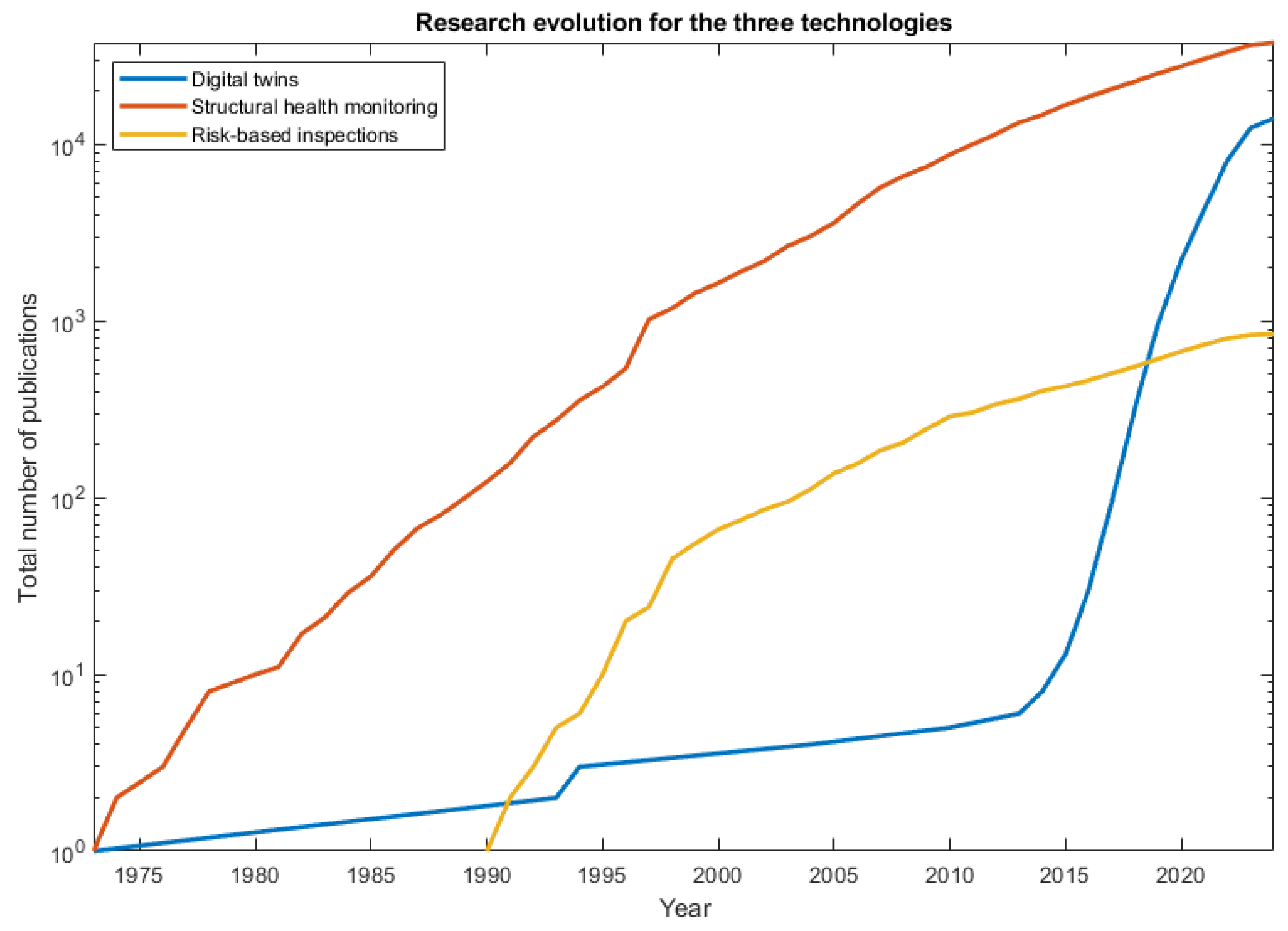
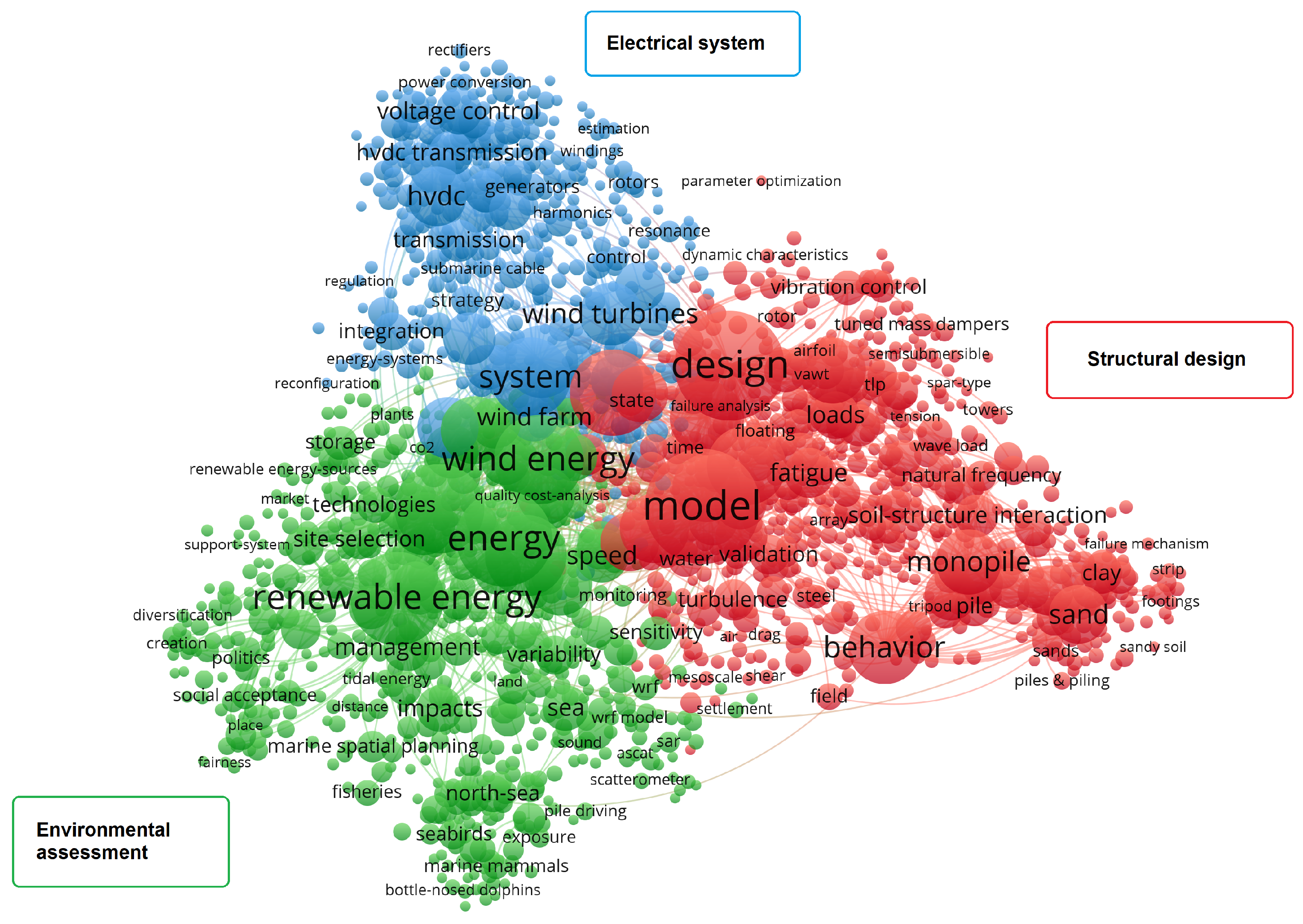


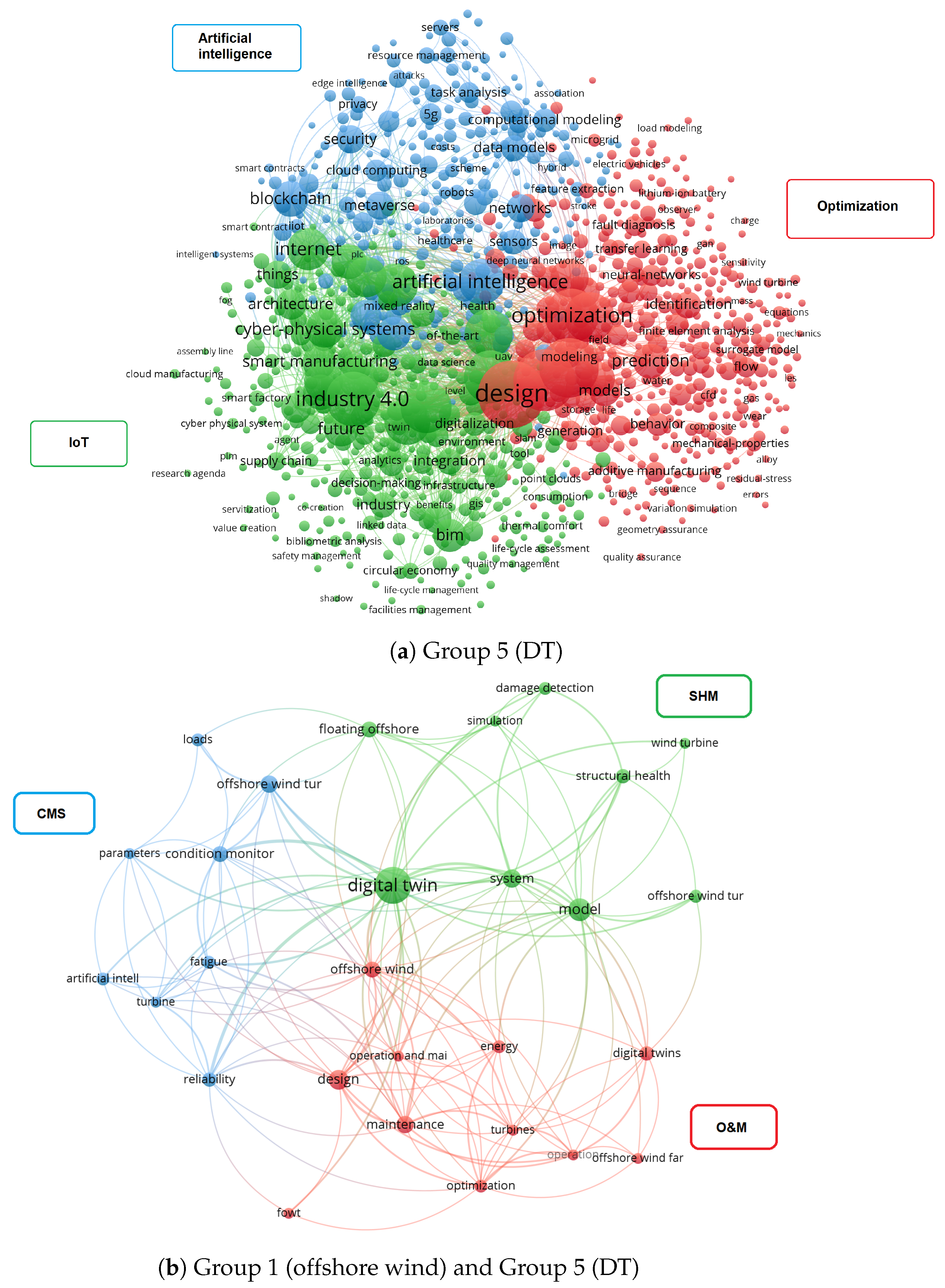
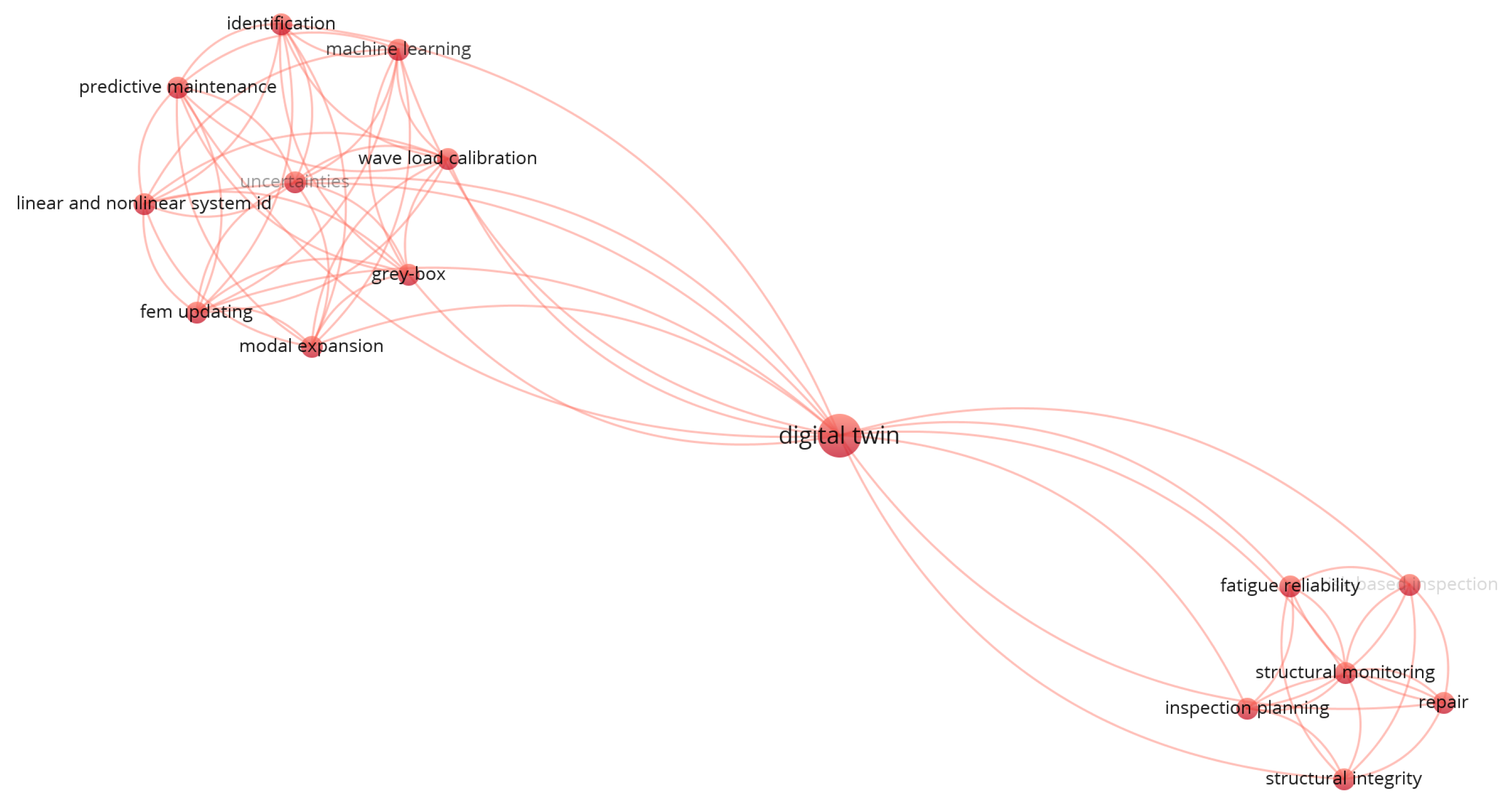

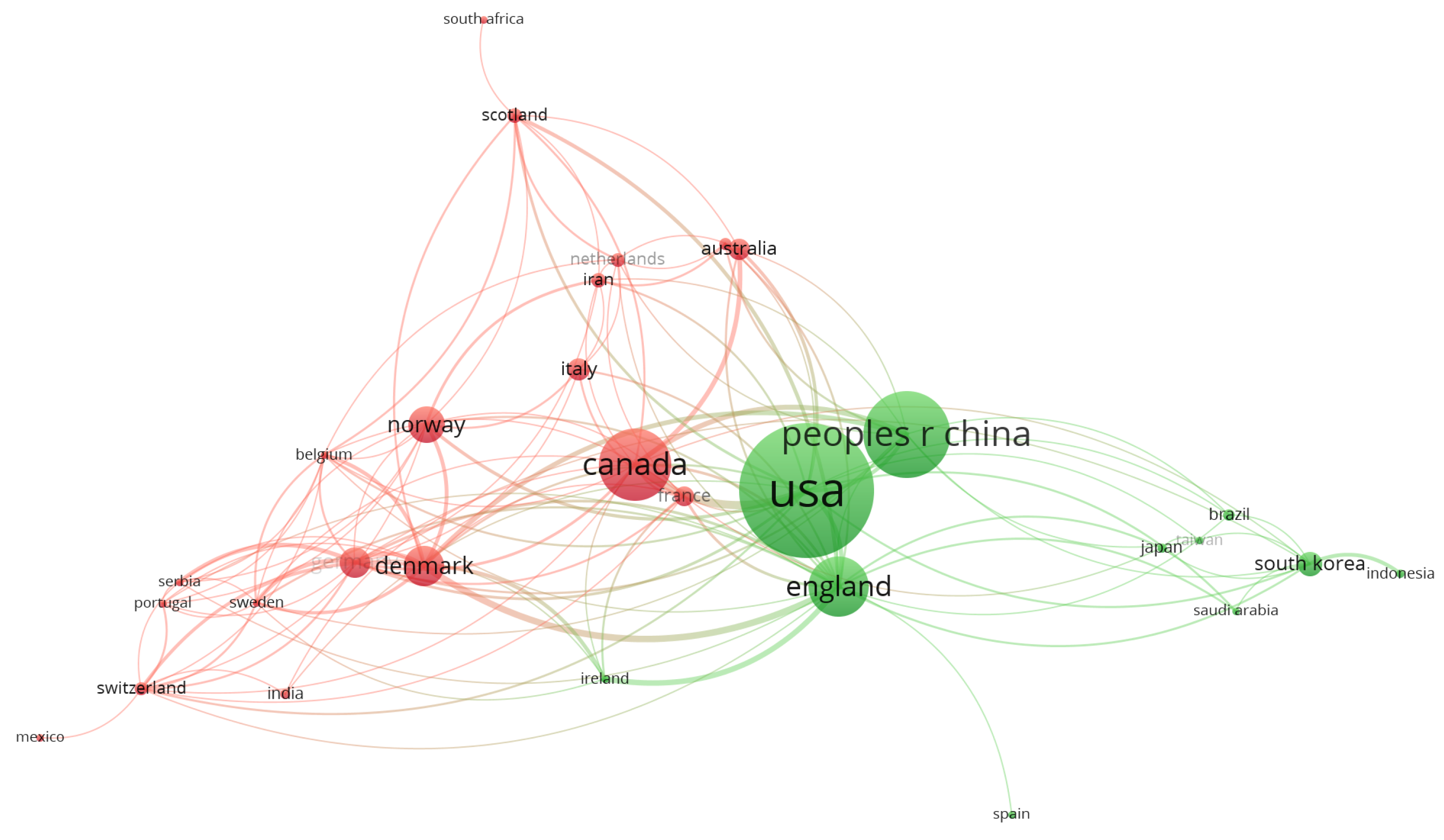

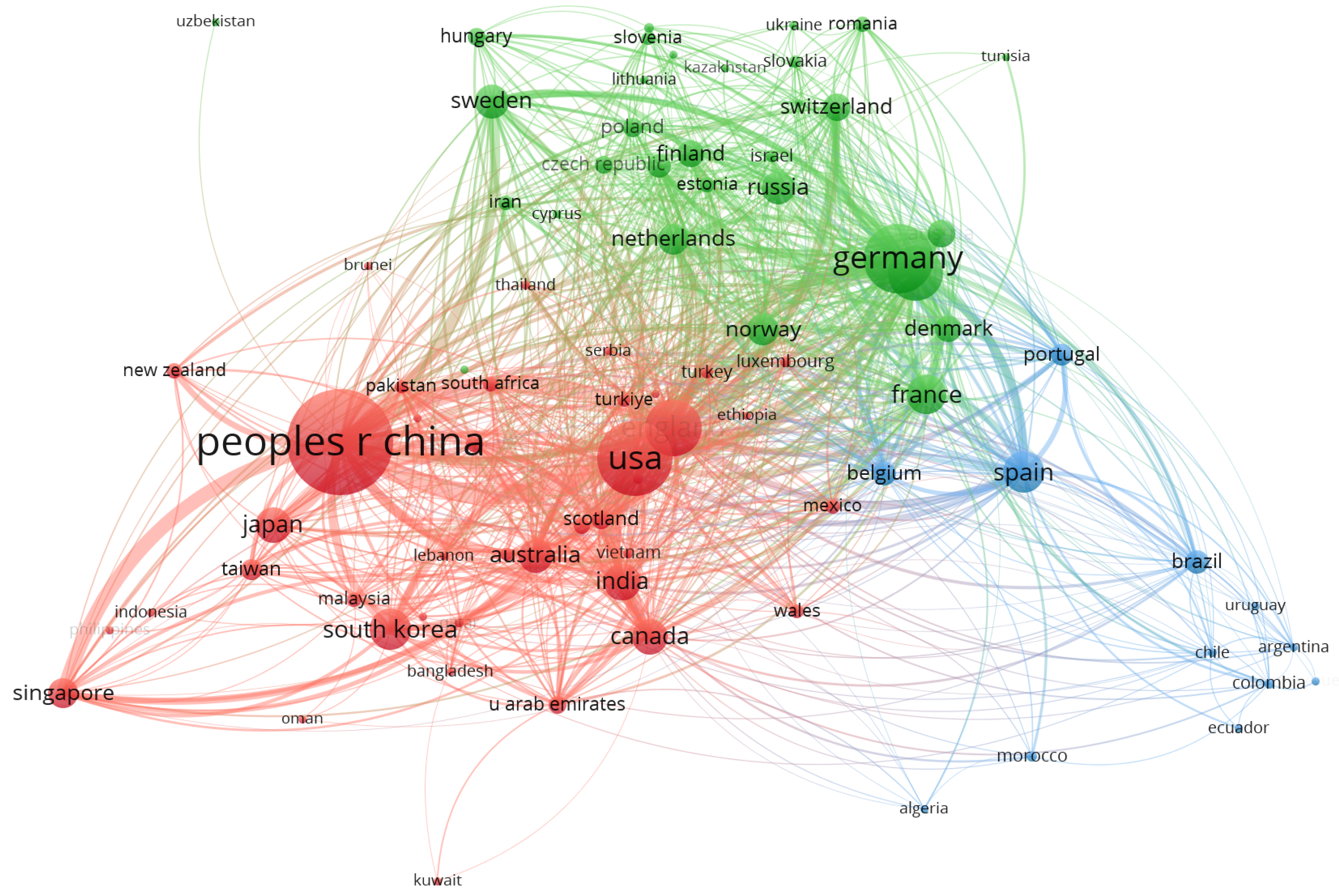
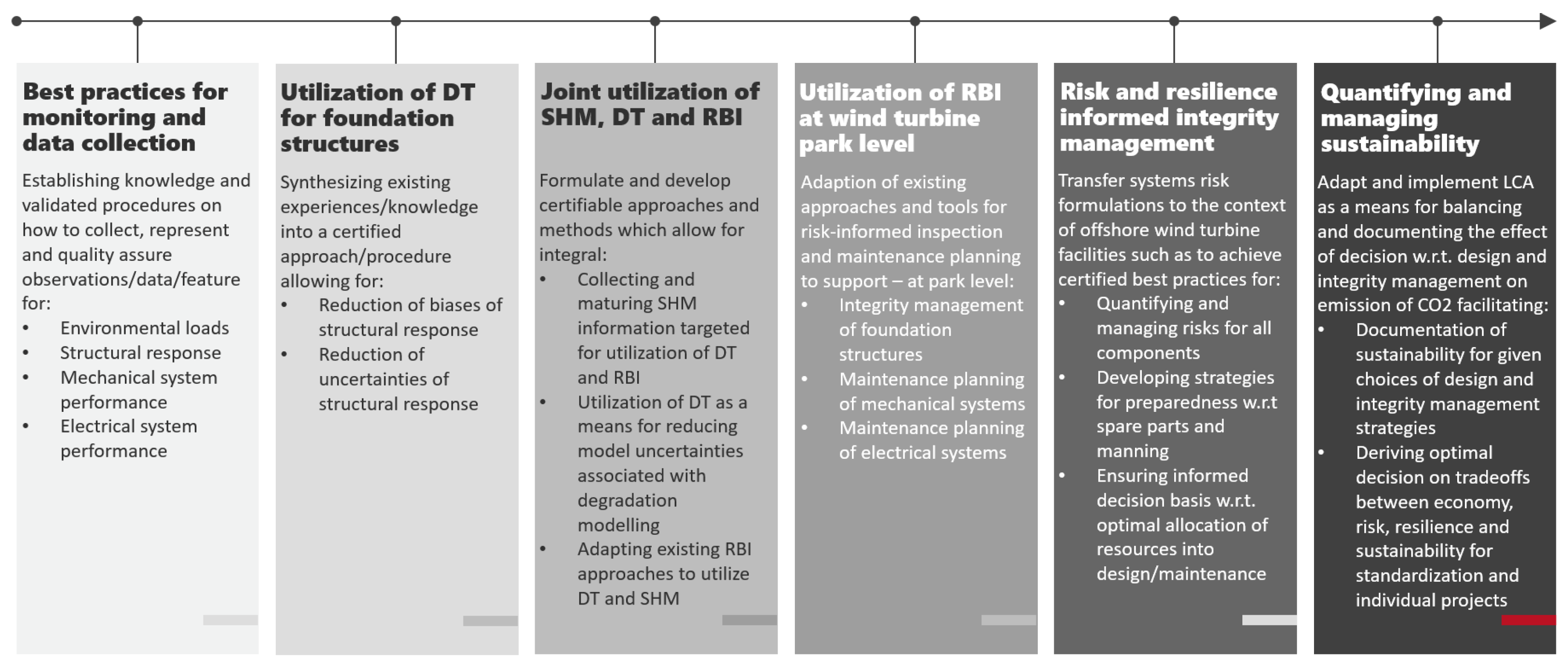
Disclaimer/Publisher’s Note: The statements, opinions and data contained in all publications are solely those of the individual author(s) and contributor(s) and not of MDPI and/or the editor(s). MDPI and/or the editor(s) disclaim responsibility for any injury to people or property resulting from any ideas, methods, instructions or products referred to in the content. |
© 2025 by the authors. Licensee MDPI, Basel, Switzerland. This article is an open access article distributed under the terms and conditions of the Creative Commons Attribution (CC BY) license (https://creativecommons.org/licenses/by/4.0/).
Share and Cite
Bull, T.; Liu, M.; Nielsen, L.; Faber, M.H. Enhancing Offshore Wind Turbine Integrity Management: A Bibliometric Analysis of Structural Health Monitoring, Digital Twins, and Risk-Based Inspection. Energies 2025, 18, 681. https://doi.org/10.3390/en18030681
Bull T, Liu M, Nielsen L, Faber MH. Enhancing Offshore Wind Turbine Integrity Management: A Bibliometric Analysis of Structural Health Monitoring, Digital Twins, and Risk-Based Inspection. Energies. 2025; 18(3):681. https://doi.org/10.3390/en18030681
Chicago/Turabian StyleBull, Thomas, Min Liu, Linda Nielsen, and Michael Havbro Faber. 2025. "Enhancing Offshore Wind Turbine Integrity Management: A Bibliometric Analysis of Structural Health Monitoring, Digital Twins, and Risk-Based Inspection" Energies 18, no. 3: 681. https://doi.org/10.3390/en18030681
APA StyleBull, T., Liu, M., Nielsen, L., & Faber, M. H. (2025). Enhancing Offshore Wind Turbine Integrity Management: A Bibliometric Analysis of Structural Health Monitoring, Digital Twins, and Risk-Based Inspection. Energies, 18(3), 681. https://doi.org/10.3390/en18030681





